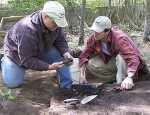Archeologists study Camp Clark's prisoner of war history

Special to the Daily Mail
CAMP CLARK -- Archaeologists from the AMEC Corporation, with help from volunteer students at Cottey College in Nevada, have completed the second phase of a search for artifacts from the former World War II prisoner of war camp. A future timber harvest and prescribed burns for the sake of conservation of wildlife habitat prompted the search for artifacts in the area prior to disturbance in compliance with Section 106 of the National Historic Preservation Act.
"We needed to make sure the area was clear of historical items before we proceed," said Regina Meyer, archaeologist for the Missouri National Guard's Environmental Office. "This project is different than some of the others we have done around the state," said Grant Day, project archaeologist for AMEC. "You don't normally dig a whole lot of sites from the 1940s. The artifacts we're looking at are a lot newer than we're used to but the context is interesting," he said.

Camp Clark (once named Camp Hadley) was commissioned in 1908 as a firing range for members of the National Guard. Its name was changed to Clark in honor of Brigadier General Harvey C. Clark three days after he died in 1921. During World War II, between 3,000 -- 5,000 prisoners of war from Italy and Germany were brought to Camp Clark. The camp is now used for field training exercises by the National Guard.
"Basically, we're trying to learn about the daily life of prisoners," said Day. "Out of their context, these items we're finding would seem rather mundane since they are so recent. That's the whole key to archaeology is the context," he said.
Day and his co-worker, John Bybee, surveyed the camp a couple of months ago during their first phase of the study. They returned to dig in the areas deemed most likely to contain artifacts according to soil density analysis, metal detection, authentic maps of the camp layout and lessons learned from a study conducted at another former prison camp in Texas.
"In Texas, they found most of the items by the entrances to the buildings and by the lavatory, so that's where we concentrated most of our efforts," Day said.
Items pulled from the ground included foreign coins, a small hand-carved wooden dog, remnants of boots, bottles, ointment tubes, lots of glass ink wells and a couple of deteriorated pieces of paper with German text. Day said the text will be interpreted once it is safely in the lab. Several rusted and unrecognizable objects were also pulled from the ground.
"It's a time consuming process. You can't just rush through it," said Bybee as he carefully scraped the ground inside a hand-dug pit. This is my first field experience," said Angela Phillips, a Cottey College student and future anthropologist. "They pretty much threw me right into it," she said. Day estimated about 90 percent of items recovered came from a mysterious collective deposit unearthed beside the lavatory. A few buttons and other metal objects were found around the rest of the site.
The locations of extracted items were noted as they were marked and bagged for future reference.
Day said his team will take artifacts to the lab where they will look at manufacturing marks, dates and any clues which might help depict prison life at Camp Clark.
"A lot of times we get back to the lab and discover more items once we clean it all up," Day said.
"We're pretty satisfied with what we found. We covered the area thoroughly, so we're satisfied," Meyer said on behalf of the Missouri National Guard.
